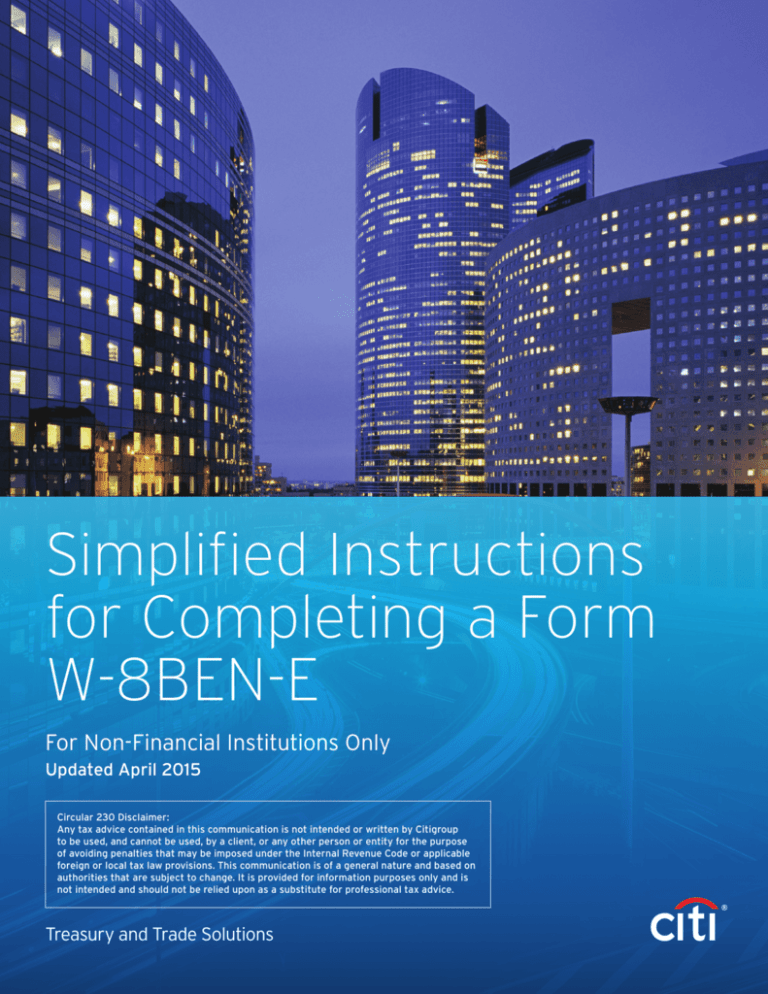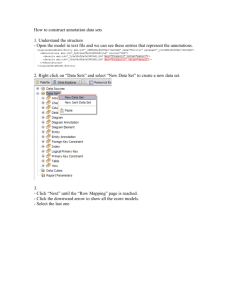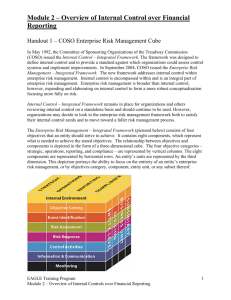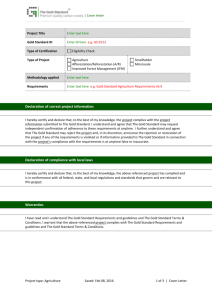
Simplified Instructions
for Completing a Form
W-8BEN-E
For Non-Financial Institutions Only
Updated April 2015
Circular 230 Disclaimer:
Any tax advice contained in this communication is not intended or written by Citigroup
to be used, and cannot be used, by a client, or any other person or entity for the purpose
of avoiding penalties that may be imposed under the Internal Revenue Code or applicable
foreign or local tax law provisions. This communication is of a general nature and based on
authorities that are subject to change. It is provided for information purposes only and is
not intended and should not be relied upon as a substitute for professional tax advice.
Treasury and Trade Solutions
This guide is intended for use in completing a Form W-8BEN-E (February 2014
version) to document the foreign status and the FATCA status of a legal entity
that is not a “U.S. Person.” For definitions of important terms (indicated in
quotes), please see the Appendix.
These step-by-step instructions are targeted to entities that are not “Financial
Institutions” for FATCA purposes and who are opening a bank deposit account or
investing in time deposits. This guide only includes instructions relevant to these
particular situations. If you are completing this Form on behalf of a “Financial
Institution” or are opening a custodial account for securities or entering into
other transactions, please use the official IRS instructions instead.
Simplified Instructions for Completing a Form W-8BEN-E
Step 1: Confirm that you are not precluded from using
Form W-8BEN-E:
Review the situations listed at the top of the Form under the header “Do NOT use this form if.” If any
of these situations apply to you, please use the form indicated, instead of Form W-8BEN-E.
Step 2: Identify the “Beneficial Owner” of the Account in Part I
Line 1 (Name of Beneficial Owner): Enter the full name of the legal entity that is the “Beneficial Owner.”
The entity name should conform to the name as shown in the formation document, including any
amendments. Please do not use any abbreviations other than those commonly used to indicate the type of
entity (e.g., S.A., A.G., etc.).
Line 2 (Country of organization): Enter the name of the country in which the legal entity was created,
organized, incorporated or governed. Please do not abbreviate the country name. However, if this country
is the United States, you ordinarily should not be completing a Form W-8, but should complete IRS Form
W-9 instead.
Line 3 (Disregarded Entity): If you are a “disregarded entity” but are NOT a financial institution, leave
line 3 blank.
Line 4 (Entity Classification): See instructions in Step 3.
Line 5 (FATCA Status): See instructions in Step 4.
Line 6 (Permanent Residence Address): Enter the Permanent Residence Address of the legal entity.
Include the street name or rural route, apartment or suite number, and the country name (please do not
abbreviate the country name), but do NOT use:
• A post office box (unless that is the registered address of the entity);
• An address at a financial institution;
• An address used solely for mailing purposes, or
• An in-care-of address (unless that is the registered address of the entity).
The permanent residence address of the entity is the address in the country where the entity claims to
be a resident for purposes of that country’s income tax. If the entity does not have a tax residence in any
country, the permanent residence address is where it maintains its principal office.
Line 7 (Mailing Address): Enter your mailing address if different from the Permanent Residence Address.
Please do not abbreviate the country name.
Line 8 (U.S. TIN): If you have a U.S. taxpayer identification number (TIN), enter it on this line. A U.S. TIN
is not required to obtain a reduced rate or exemption from U.S. withholding on interest paid on a bank
deposit account or a time deposit.
Line 9a (GIIN): Not applicable. A legal entity is not required to have a GIIN, unless it is a reporting
‘‘Financial Institution,’’ a trustee of a trustee documented trust, a direct reporting NFFE or a sponsored
direct reporting NFFE.
Line 9b (Foreign TIN): For a deposit account opened at the U.S. office of a bank, you MUST provide the
foreign taxpayer identification number issued to you by the country in which you are a tax resident, unless:
• You have not been issued a foreign TIN, or
• That country does not issue TINs.
Line 10 (Reference numbers): If the entity filing the Form W-8BEN-E is the single owner of a “disregarded
entity,” use line 10 to identify the disregarded entity (by name) and thereby associate the Form with an
account held by the disregarded entity.
3
4
Treasury and Trade Solutions
Step 3: Determine the Entity Type
Mark the one box that applies on line 4. Determine the classification of the legal entity based on U.S.
tax principles. Below is a description of some of these U.S. tax principles.
A non-U.S. business entity is a “per se” foreign corporation, if it is a type of entity described in Treasury
Regulations section 301.7701-2(b)(8) for the country in which the entity is incorporated.
If a business entity (other than a per se foreign corporation) has only one owner, it is classified as either a
corporation or a disregarded entity. If the single owner does not have limited liability, the non-U.S. entity is
disregarded as an entity separate from its owner and the single owner should complete the applicable U.S.
tax form in its own name. If the single owner does have limited liability, the non-U.S. entity is classified as
a corporation.
Non-U.S. business entities that have two or more members are classified as either a corporation or a
partnership. If no member of the business entity has unlimited liability for the debts of the entity, the entity
has a default classification of a corporation. If any member has unlimited liability, the business entity has a
default classification of a partnership.
Business entities, other than per se foreign corporations, may elect to be classified in a manner different
from their default classification (a disregarded entity, a partnership or a corporation) by filing a checkthe-box election on Form 8832 with the IRS. If such an election has been made, the elected classification
applies (and not the default classification) for purposes of completing Form W-8.
Step 4: Determine the FATCA Status of the Entity
Mark the one box that applies on line 5 and complete the Part of the Form associated with that FATCA
status. Accordingly, you should not complete any other Parts among Parts IV through XVIII.
The first 14 FATCA Statuses listed on line 5 (plus a Part XVII Territory Financial Institution) apply only to
Foreign Financial Institutions (FFIs) and thus do not apply to non-financial institutions. The remaining
FATCA statuses (Parts XIII through XVI and Parts XVIII through XXVIII) may be broken down into three
categories as shown below:
To determine whether a particular FATCA status applies in your situation, please read the qualifications for
that status as recited in the Part of the Form associated with that status. If you need additional information,
you should refer to the complete IRS instructions to Form W-8BEN-E or consult your tax advisor.
Category 1: Exempt Beneficial Owners
FATCA Status
Complete Part
Foreign government, government of a U.S. possession or foreign central bank of issue
XIII
International organization
XIV
Exempt retirement plan
XV
Entity wholly owned by exempt beneficial owners
XVI
Note: Category 1 FATCA statuses do not apply with respect to obligations (e.g., bank deposit accounts
or time deposits) held by the beneficial owner in connection with the conduct of a commercial financial
activity of a type engaged in by an insurance company, custodial institution or a depository institution.
Simplified Instructions for Completing a Form W-8BEN-E
5
Category 2: Excepted Non-Financial Foreign Entities (NFFEs)
FATCA Status
Complete Part
Nonfinancial group entity
XVIII
Excepted nonfinancial start-up company
XIX
Nonfinancial entity in liquidation or bankruptcy
XX
501(c) organization
XXI
Nonprofit organization
XXII
Publicly traded NFFE or NFFE affiliate of a publicly traded corporation
XXIII
Excepted Territory NFFE
XXIV
Active NFFE
XXV
Excepted Inter-Affiliate FFI
XXVII
Direct Reporting NFFE
N/A
Sponsored direct reporting NFFE
XXVIII
Note: An excepted NFFE is excused from any requirement to make representations about, or to disclose the
identity of, its owners or controlling persons to a withholding agent.
Note: An NFFE whose stock is publicly traded on an established securities market or any of its non-U.S.
affiliates may claim a FATCA exception by marking the applicable box on line 5 and completing Part XXIII.
For the Parent corporation: Mark box 37a and enter the name of one securities exchange where the
stock is regularly traded. For an affiliated corporation: Mark box 37b and enter the name of the Parent
corporation whose stock is publicly traded.
Category 3: Passive NFFEs
FATCA Status
Complete Part
Passive NFFE under Treasury Regulations
XXVI (and XXX,
if applicable)
Passive NFFE under an IGA
XXVI (and attach
a certification
and a list of
controlling
U.S. persons)
Note: A passive NFFE must mark the box on line 40a to certify that it is not an excepted NFFE. If the claim
is made under the Treasury Regulations, a passive NFFE must either represent on line 40b (by marking the
box) that is has no substantial U.S. owners, or if the passive NFFE has substantial U.S. owners, it must mark
box 40c and identify each substantial U.S. owner (by name, address and TIN) in Part XXX.
On the other hand, if the claim is made under an “Intergovernmental Agreement” (IGA), a passive NFFE
should not mark box 40b or 40c and should not complete Part XXX. Instead, a passive NFFE making
a claim under an IGA must provide an attachment to the Form W-8BEN-E on which it identifies the
jurisdiction that is treated as having an IGA in effect, describes its status as a Passive NFFE in accordance
with the applicable IGA. The attachment should also include a certification as to whether or not the passive
NFFE has controlling U.S. citizens or residents, and if so, a list containing the identity (by name, address
and TIN) of each controlling U.S. person.
6
Treasury and Trade Solutions
Step 5: You may by-pass Parts II and III
Part II (Disregarded Entity or Branch Receiving Payment): Applies only to a disregarded entity or branch
that is an FFI located in a country other than the country identified on line 2.
Part III (Claim for Treaty Benefits): You do not need to claim U.S. treaty benefits to obtain a reduced rate or
exemption from U.S. withholding on interest on a bank deposit account or a time deposit.
Step 6: Execute the Form in Part XXIX (Certification)
To execute the Form W-8BEN-E and attest to the correctness and completeness of the information and
representations provided on the Form, an authorized individual must sign the form and provide all the
required information in the spaces indicated in Part XXIX:
• Sign the form by hand
• Print the name of the signer
• Enter the date on which the Form is signed in a MM-DD-YYYY format
• Mark the box to certify that the signatory has capacity to sign for
the entity identified on line 1 of the Form
An individual who has capacity to sign a tax form on behalf of a corporation includes an officer or another
individual authorized to sign the form by a board resolution or a tax power of attorney.
Please deliver the completed Form W-8BEN-E to your Citi contact person by hand, postal service, courier,
fax or email with the Form attached. If you deliver a paper Form to Citi, you must provide us with the handsigned original and not a photocopy.
Circular 230 Disclaimer: Any tax advice contained in this communication is not intended or written by
Citigroup to be used, and cannot be used, by a client, or any other person or entity for the purpose of
avoiding penalties that may be imposed under the Internal Revenue Code or applicable foreign or local
tax law provisions. This communication is of a general nature and based on authorities that are subject to
change. It is provided for information purposes only and is not intended and should not be relied upon as a
substitute for professional tax advice.
Simplified Instructions for Completing a Form W-8BEN-E
7
Appendix: Important Definitions (In alphabetical order)
Notes:
1.
Any reference to sections of the U.S. Internal Revenue Code will
be denoted as “Code section…”.
2. The definitions contained in this Appendix are derived from
regulations published by the U.S. Department of Treasury and
the Internal Revenue Service. The definitions used in a Model 1
IGA may contain differences from these definitions. If you are
making a claim under the provisions of a Model 1 IGA, please
refer to the provisions of the applicable IGA.
Beneficial Owner:
The beneficial owner of income is generally the person who is
required under U.S. tax principles to include the payment in gross
income on a tax return. A person is not a beneficial owner of income,
however, to the extent that person is receiving the income as a
nominee, agent or custodian, or to the extent the person is a conduit
whose participation in a transaction is disregarded. In the case of
amounts paid that do not constitute income, beneficial ownership is
determined as if the payment were income.
Foreign partnerships, foreign simple trusts and foreign grantor
trusts are not the beneficial owners of income paid to the
partnership or trust. The beneficial owners of income paid to a
foreign partnership are generally the partners in the partnership,
provided that the partner is not itself a partnership, foreign simple
or grantor trust, nominee or other agent. The beneficial owners of
income paid to a foreign simple trust (that is, a foreign trust that
is described in Code section 651(a)) are generally the beneficiaries
of the trust, if the beneficiary is not a foreign partnership, foreign
simple or grantor trust, nominee or other agent. The beneficial
owners of income paid to a foreign grantor trust (that is, a foreign
trust to the extent that all or a portion of the income of the trust
is treated as owned by the grantor or another person under Code
sections 671 through 679) are the persons treated as the owners of
the trust. The beneficial owner of income paid to a foreign complex
trust (that is, a foreign trust that is not a foreign simple trust or
foreign grantor trust) is the trust itself.
Disregarded Entity:
A disregarded entity is an entity that is disregarded as an entity
separate from its single owner for U.S. tax purposes. A non-U.S.
entity (other than a per se foreign corporation) is classified by
default as a disregarded entity if its single owner has unlimited
liability. Alternatively, an eligible entity can make an election to
be treated as a disregarded entity on a Form 8832 filed with and
approved by the IRS.
Established Securities Market:
An established securities market means:
• A foreign securities exchange that is officially recognized,
sanctioned or supervised by a governmental authority of the
foreign country in which the market is located, and has an
annual value of shares traded on the exchange (or a predecessor
exchange) exceeding $1 billion during each of the three calendar
years immediately preceding the calendar year in which the
determination is being made;
• A national securities exchange that is registered under section 6
of the Securities Exchange Act of 1934 (15 USC 78f) with the U.S.
Securities and Exchange Commission;
• Any exchange designated under a Limitation on Benefits article of
an income tax treaty with the United States that is in force, or
• Any other exchange that the Secretary may designate in
published guidance.
Expanded Affiliated Group:
An expanded affiliated group is generally defined in accordance with
the principles of Code section 1504(a) to mean one or more chains
of members connected through ownership by a common parent
entity if the common parent entity directly owns stock or other
equity interest meeting the ownership test in Temporary Regulations
section 1.1471-5T(i)(4) in at least one of the other members.
Financial Institution:
A financial institution generally means an entity that is a depository
institution, custodial institution, investment entity or an insurance
company (or holding company of an insurance company) that issued
cash value insurance or annuity contracts. For more information,
see Treasury Regulations section1.1471-5(e) or the provisions of the
applicable IGA.
Foreign Person:
A foreign person includes a foreign corporation, a foreign partnership,
a foreign trust, a foreign estate, and any other person that is not a U.S.
person. Generally, a payment to a U.S. branch of a foreign person is a
payment to a foreign person.
Intergovernmental Agreement:
An Intergovernmental Agreement (IGA) means a Model 1 IGA or a
Model 2 IGA entered into between the U.S. Department of Treasury
and a foreign government or its designated authorities. For a list of
jurisdictions treated as having in effect a Model 1 or Model 2 IGA,
see http://www.treasury.gov/resource-center/tax-policy/treaties/
Pages/FATCA-Archive.aspx.
Member of an Expanded Affiliated Group:
A corporation, a partnership or trust that meets the common
ownership requirement, but excluding corporations described in
sub-paragraphs (1), (4), (6), (7) or (8) of Code section 1504(b), is a
Member of an Expanded Affiliated Group. A corporation meets the
ownership requirement if it is owned by another member entity or by
the common parent entity if more than 50 percent of the total voting
power of the stock of such corporation and more than 50 percent
of the total value of the stock of such corporation is owned directly
by one or more other members of the group (including the common
parent entity). For further information on the application of the
ownership test, see Temporary Regulations section 1.1471-5T(i)(4).
Passive Income:
Unless excepted, the term passive income means the portion of gross
income that consists of:
1. Dividends, including substitute dividend amounts;
2. Interest;
8
Treasury and Trade Solutions
3. Income equivalent to interest, including substitute interest and
amounts received from or with respect to a pool of insurance
contracts if the amounts received depend in whole or part upon the
performance of the pool;
4. An individual retirement plan as defined in Code
section 7701(a)(37);
4. Rents and royalties, other than rents and royalties derived in the
active conduct of a trade or business conducted, at least in part, by
employees of the NFFE;
6. Any State, the District of Columbia, any U.S. territory, any
political subdivision of any of the foregoing, or any wholly owned
agency of instrumentality of any one or more of the foregoing;
5. Annuities;
7.
6. The excess of gains over losses from the sale or exchange of
property that gives rise to passive income described in 1-5 above;
8. Any real estate investment trust as defined in Code
section 856;
7. The excess of gains over losses from transactions (including
futures, forwards and similar transactions) in any commodities but
not including:
9. Any regulated investment company as defined in Code
section 851 or any entity registered with the Securities
Exchange Commission under the Investment Company
Act of 1940 (15 U.S.C. 80a-64);
• Any commodity hedging transaction described in Code section
954(c)(5)(a), determined by treating the entity as a controlled
foreign corporation; or
• Active business gains or losses from the sale of commodities,
but only if substantially all the foreign entity’s commodities
are properly described in sub-paragraphs (1), (2) or (8) of
Code section 1221(a);
8. Excess of foreign currency gains over foreign currency losses
(as defined in Code section 988(b)) attributable to any section
988 transaction;
5. The United States or any wholly owned agency or
instrumentality thereof;
Any bank as defined in Code section 581;
10. Any common trust fund as defined in Code section 584(a);
11. Any trust that is exempt from U.S. tax under Code section
664(c) or is described in Code section 4947(a)(1);
12. A dealer in securities, commodities or derivative financial
instruments (including notional principal contracts, futures,
forwards and options) that is registered as such under the
laws of the United States or any State;
13. A broker; and
9. Net income from notional principal contracts as defined in
Treasury Regulation section 1.1446-3(c)(1);
14. Any tax-exempt trust under a Code section 403(b) plan or a
Code section 457(g) plan.
10. Amounts received under cash value insurance contracts; or
Substantial U.S. Owner:
A substantial U.S. owner means any specified U.S. person that:
11. Amounts earned by an insurance company in connection with its
reserves for insurance and annuity contracts.
Regularly Traded:
The stock of a corporation is regularly traded on one or more
established securities markets for a calendar year if:
• Owns, directly or indirectly, more than 10 percent (by vote or
value) of the stock of any foreign corporation;
• Owns, directly or indirectly, more than 10 percent of the profits
or capital interests in a foreign partnership;
• One or more classes of stock of the corporation that, in the
aggregate, represent more than 50 percent of the total combined
voting power of all classes of stock of such corporation entitled to
vote and the total value of the stock of such corporation are listed
on such market or markets during the prior calendar year; and
• Is treated as an owner of any portion of a foreign trust under
Code sections 671 through 679; or
• With respect to each class of stock relied on to meet the morethan-50–percent listing requirement:
U.S. Person:
A U.S. person includes:
—— Trades in each such class are effected, other than in de
minimis quantities, on such market or markets on at least
60 days during the prior calendar year; and
—— The aggregate number of shares in each such class that are
traded on such market or markets during the prior year are at
least 10 percent of the average number of shares outstanding
in that class during the prior calendar year.
Specified U.S. Person:
A Specified U.S. Person is any U.S. person other than:
1.
A corporation the stock of which is regularly traded on one or
more established securities markets;
2. Any corporation that is a member of the same expanded
affiliated group as a corporation described immediately above;
3.
Any organization exempt from taxation under Code
section 501(a);
• Holds, directly or indirectly, more than a 10 percent beneficial
interest in a trust.
• A U.S. citizen or resident alien;
• A corporation incorporated under the laws of the United States, a
State or the District of Columbia;
• A partnership organized under the laws of the United States, a
State or the District of Columbia;
• A trust if (1) a U.S. court is able to exercise primary supervision
over the administration of the trust, and (2) one or more U.S.
persons have authority to exercise control over all the substantial
decisions of the trust.
Treasury and Trade Solutions
citi.com/treasuryandtradesolutions
© 2015 Citibank, N.A. All rights reserved. Citi and Arc Design is a registered service mark of Citigroup Inc.
1292897 GTS26472 05/15







